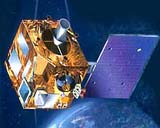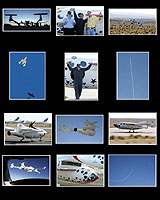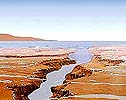
|
|
PREVIOUS ISSUE
SEARCH SPACEDAILY SATURN DAILY MARSDAILY SPACEMART SPACEWAR SPACE TRAVEL TERRADAILY SPACE.TV ASTRONAUTIX ABOUT US |
 Boeing Signs Agreement With India To Make Satellites
Boeing Signs Agreement With India To Make SatellitesBangalore, India (AFP) Jun 22, 2004  The US government has approved a licence authorising Boeing Co. to enter into talks with India's space agency for jointly developing and marketing satellites, an official said Tuesday. Kenneth Juster, US Under Secretary of Commerce, told Indian and US delegates at a space conference in this southern Indian city of Bangalore that clearance was given last week by the new Indian government.
The US government has approved a licence authorising Boeing Co. to enter into talks with India's space agency for jointly developing and marketing satellites, an official said Tuesday. Kenneth Juster, US Under Secretary of Commerce, told Indian and US delegates at a space conference in this southern Indian city of Bangalore that clearance was given last week by the new Indian government. |

|
|
SpaceShipOne Lands After Touching Space At 100km Up Mojave (AFP) Jun 21, 2004  A US rocket plane Monday became the first privately-financed manned flight into space in a landmark step toward opening up exploration beyond the Earth's atmosphere. SpaceShipOne, designed by pioneer engineer Burt Rutan and paid for by Microsoft co-founder Paul Allen, went to an altitude of just over 100 kilometers (62 miles), said Rutan's company, which admitted problems had prevented the craft reaching its target altitude.
A US rocket plane Monday became the first privately-financed manned flight into space in a landmark step toward opening up exploration beyond the Earth's atmosphere. SpaceShipOne, designed by pioneer engineer Burt Rutan and paid for by Microsoft co-founder Paul Allen, went to an altitude of just over 100 kilometers (62 miles), said Rutan's company, which admitted problems had prevented the craft reaching its target altitude. |
New Entrants Versus Incumbents: Triumph of Truth and Technology Mojave CA (SPX) Jun 21, 2004
Mojave CA (SPX) Jun 21, 2004Today's successful launch of the private SpaceShipOne high above the sands of California's Mojave Desert, marks the beginning of a new era of incumbent space agencies being challenged by new players, write Michael Potter and Rick Tumlinson. Moon To Mars: What's Beyond?  Moffet Field CA (SPX) Jun 21, 2004
Moffet Field CA (SPX) Jun 21, 2004On January 14, 2004, President George W. Bush announced a new vision for America's civil space program that calls for human and robotic missions to the Moon, Mars, and beyond: |
Washington (SPX) Jun 22, 2004  Scientists have discovered a striking similarity between certain ocean currents on Earth and the bands that characterize the surface of large, gaseous planets like Jupiter.
Scientists have discovered a striking similarity between certain ocean currents on Earth and the bands that characterize the surface of large, gaseous planets like Jupiter. |
Planetary Uncertainty Principle Moffet Field (SPX) Jun 22, 2004
Moffet Field (SPX) Jun 22, 2004To terraform a planet is to change its environment, making it livable for humans and other Earth-based life forms. Most life on Earth could not survive on Mars today. Should We Terraform? Part III  Moffet Field CA (SPX) Jun 17, 2004
Moffet Field CA (SPX) Jun 17, 2004At the Astrobiology Science Conference on March 30, scientists and science fiction writers faced off in front of a packed audience to debate the promise and pitfalls of terraforming Mars. In part 3 of this 7-part series, David Grinspoon says we have an ethical imperative to bring life to Mars. |
Comet's Dust Clouds Hit NASA Spacecraft Like Thunderbolt Chicago IL (SPX) Jun 21, 2004
Chicago IL (SPX) Jun 21, 2004Two swarms of microscopic cometary dust blasted NASA's Stardust spacecraft in short but intense bursts as it approached within 150 miles of Comet Wild 2 last January, data from a University of Chicago instrument flying aboard the spacecraft has revealed. |
Gilat Selected To Deploy Rural Telephony Network In Papua Port Morseby (SPX) Jun 22, 2004
Port Morseby (SPX) Jun 22, 2004Telikom Papua New Guinea (PNG) and Gilat Satellite Networks Ltd. today announced that Gilat has been selected by Telikom PNG to provide a hub and 500 DialAw@y IP VSATs for rural telephony services across the island country. The network is expected to expand to 2,000 sites and will provide support for IP, education and health applications. |
ESA And EADS-CASA Sign Contract To Build Instrument For The SMOS Mission Paris (ESA) Jun 21, 2004
Paris (ESA) Jun 21, 2004A significant milestone in the development of ESA�s Soil Moisture and Ocean Salinity (SMOS) mission was reached last week when the contract to build the payload was signed between ESA and EADS, CASA from Spain. Carolinas Bounce Back From Hurricanes  Raleigh NC (SPX) Jun 16, 2004
Raleigh NC (SPX) Jun 16, 2004After receiving the brunt of powerful hurricanes in 1996 and 1999, the Neuse River and Estuary and western Pamlico Sound in eastern North Carolina appear to have suffered few long-term ill effects from the storms, and have actually benefited ecologically in some ways from the storms' scouring effects. |
Whole Body Imaging Allows Better Understanding Of Immune System Boston MA (SPX) Jun 16, 2004
Boston MA (SPX) Jun 16, 2004New whole body positron-emission tomography (PET) imaging techniques are allowing scientists to actually watch as immune system cells find and respond to tumors or infection. Ecology Drives The Worldwide Distribution Of Human Diseases  Paris (SPX) Jun 16, 2004
Paris (SPX) Jun 16, 2004Mounting evidence suggests that ecological and climatic conditions influence the emergence, spread, and recurrence of infectious diseases. Global climate change is likely to aggravate climate-sensitive diseases in unpredictable ways. |
| The contents herein, unless otherwise known to be public domain, are Copyright 1995-2004 - SpaceDaily. AFP and UPI Wire Stories are copyright Agence France-Presse and United Press International. ESA Portal Reports are copyright European Space Agency. All NASA sourced material is public domain. Additional copyrights may apply in whole or part to other bona fide parties. Advertising does not imply endorsement, agreement or approval of any opinions, statements or information provided by SpaceDaily on any web page published or hosted by SpaceDaily. Privacy Statement |
